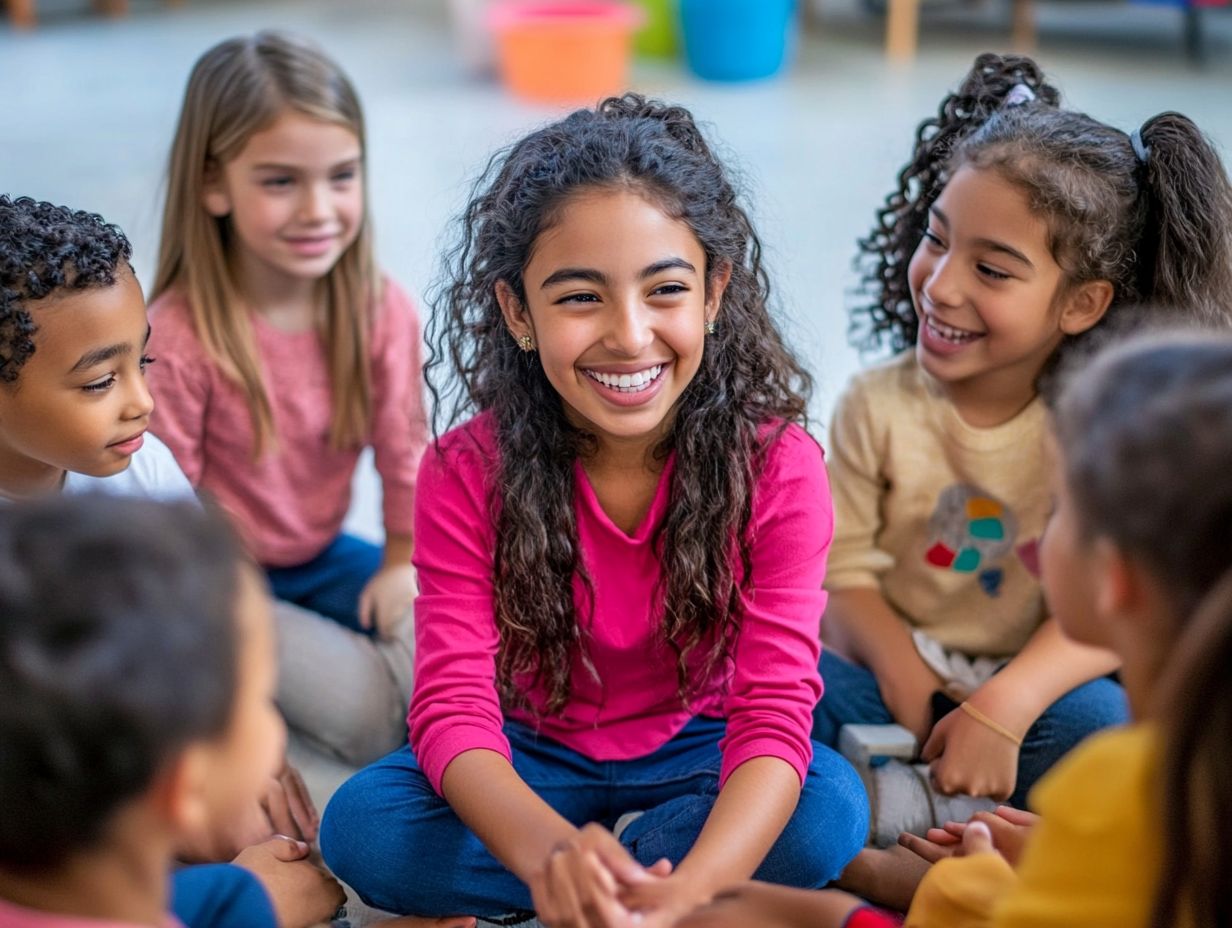How to Create a Positive Discipline Strategy
Positive discipline is a nurturing approach that encourages you to guide children with an emphasis on mutual respect, encouragement, and effective communication.
Unlike traditional punitive methods, this approach cultivates a supportive environment that empowers children to learn from their mistakes rather than fear them.
This article delves into the core principles and benefits of positive discipline, offering you practical strategies for implementation and techniques for addressing challenging behaviors.
By embracing these concepts, you can create a more harmonious atmosphere that fosters growth and development for both children and yourself.
Contents
- Key Takeaways:
- What is Positive Discipline?
- Why is Positive Discipline Important?
- What are the Benefits of Positive Discipline?
- What are the Key Elements of Positive Discipline?
- What are Some Examples of Positive Discipline Techniques?
- How to Handle Challenging Behaviors with Positive Discipline?
- Frequently Asked Questions
- What is a positive discipline strategy?
- Why is it important to have a positive discipline strategy?
- How do I create a positive discipline strategy?
- What are some examples of positive discipline strategies?
- What should I do if my current discipline strategy is not working?
- Can positive discipline strategies be used for children of all ages?
Key Takeaways:

- Clearly communicate expectations and use positive reinforcement to encourage desired behaviors.
- Be a role model and communicate effectively to establish consistency in your discipline strategy.
- When faced with challenging behaviors, identify the root cause and use positive language and problem-solving techniques to address them.
What is Positive Discipline?
Positive discipline is an approach you can adopt to guide children’s behavior, emphasizing mutual respect, understanding emotions, and establishing clear boundaries. This strategy fosters a nurturing environment that is crucial for child development.
It involves using age-appropriate techniques that focus on redirecting misbehavior while providing emotional support. Drawing from the study of how behavior is learned, positive discipline incorporates insights from prominent theorists like B.F. Skinner, promoting self-control and healthy disciplinary practices.
As an early childhood educator, you play a pivotal role in implementing positive reinforcement and teaching respect, ensuring that discipline is perceived not as punishment, but as a valuable means to support children’s growth and enhance their emotional intelligence.
Why is Positive Discipline Important?
Positive discipline is essential for creating an environment where children can truly thrive both emotionally and socially, ultimately supporting their overall development and boosting their self-esteem.
By cultivating mutual respect and fostering clear communication, you can guide children s behavior effectively while helping them to grasp their own emotions. This method of discipline goes beyond merely addressing misbehavior; it also encourages healthy strategies that promote self-regulation and emotional intelligence key components for successful child development.
What are the Benefits of Positive Discipline?
You ll be amazed by the benefits of positive discipline, enhancing your child’s emotional support while cultivating self-esteem and fostering mutual respect between them and their caregivers. This method encourages effective discipline strategies that promote positive behavior modification, resulting in improved child development outcomes and a deeper understanding of emotions.
By emphasizing respectful interactions, your child learns to navigate social situations more effectively and develops critical life skills.
This approach enables your child to take responsibility for their actions, providing them with the tools to solve problems independently. As they learn to express their feelings and understand those of others, their emotional intelligence flourishes, paving the way for strong relationships and empathy in their later years.
Positive discipline minimizes the reliance on punitive measures, which often breed fear and resentment, ultimately creating a nurturing environment where children can truly thrive. By instilling these values early on, you are equipping your child with essential skills that will serve them well throughout their development and into adulthood.
What are the Key Elements of Positive Discipline?
The key elements of positive discipline encompass mutual respect, encouragement, problem-solving, consistency, and effective communication. Together, these components create a nurturing environment that positively influences children’s behavior.
These aspects are essential for establishing a framework that fosters self-control and emotional intelligence. They enable children to learn how to constructively address misbehavior. This comprehensive approach not only directs children’s actions but also fortifies the bond between caregivers and children, laying the groundwork for healthier, more meaningful interactions.
1. Mutual Respect
Mutual respect stands as a cornerstone of positive discipline, establishing a nurturing relationship between caregivers and children that emphasizes emotional support. This principle not only encourages children to embrace the significance of respect but also aids them in recognizing how their behaviors influence those around them, fostering positive interactions in the process.
By modeling and reinforcing mutual respect, you can effectively guide children’s behavior and enhance their emotional intelligence.
When children feel valued and understood, they are far more likely to respond positively to your guidance and feedback. This reciprocal dynamic encourages them to express their emotions in constructive ways and engage in meaningful discussions about their actions.
In such a supportive environment, children cultivate empathy and learn to recognize boundaries essential skills for their social development. Respectful communication minimizes conflicts and equips children with the tools they need for effective conflict resolution, ultimately shaping them into considerate individuals who honor the feelings and rights of others.
2. Encouragement
Encouragement is an essential aspect of positive discipline, acting as a powerful form of reinforcement that elevates children’s self-esteem and inspires them to embrace positive behaviors. By acknowledging and celebrating their efforts and achievements, you can cultivate a sense of accomplishment that motivates them to continue demonstrating such positive behavior. This method not only strengthens effective discipline techniques but also creates an environment where children feel valued and confident in their abilities.
When you actively express your support and appreciation, you enable children to develop a robust sense of self-worth, which is vital for their overall growth. Your encouragement helps them realize that their hard work and good choices are recognized, leading them to internalize these positive behaviors. Over time, this can transform their approach to challenges, enabling them to tackle setbacks with resilience rather than discouragement.
A nurturing atmosphere, consistently enriched by your encouragement, fosters healthier parent-child relationships, establishing a foundation for effective communication that further enhances cooperative behavior in various settings.
3. Problem-Solving
Problem-solving is an essential skill that you can cultivate through positive discipline, enabling your child to navigate conflicts and challenges with confidence. By engaging your child in problem-solving discussions, you provide vital emotional support while teaching them respect and empathy, helping them to see things from different perspectives.
This proactive approach not only nurtures critical thinking but also encourages your child to develop resilience and adaptability when facing misbehavior and conflicts.
Creating an environment where open dialogue thrives enables your child to express their feelings and opinions while collaborating on solutions. This engagement is crucial; it builds a sense of community and belonging, allowing your child to feel truly heard and validated.
As you tackle issues together, the importance of mutual respect becomes clear, laying the foundation for healthy relationships. Problem-solving in this context instills a growth mindset, teaching your child that mistakes are just opportunities for learning, equipping them with the tools for emotional regulation and social competence in various situations.
4. Consistency

Consistency stands as a cornerstone of positive discipline, establishing clear boundaries and expectations that children can rely on for guidance. When you apply consistent strategies for behavior modification, children begin to grasp the consequences of their actions and cultivate self-control. This stability not only amplifies the effectiveness of your discipline practices but also bolsters children s sense of security, enabling them to thrive in their learning environments.
Moreover, consistency fosters trust between you and the children in your care. They come to recognize that certain behaviors will elicit predictable responses. This trust fosters a supportive atmosphere where children feel safe to express themselves and make mistakes without fear.
As they experience consistent reinforcement of desired behaviors, they are more likely to internalize these lessons, leading to enduring behavioral changes. Your consistent approach to discipline shapes behavior in powerful ways while nurturing emotional resilience, ultimately equipping children with the essential life skills they need.
5. Communication
Effective communication is essential for encouraging positive discipline, providing a platform for active listening and building mutual respect between you and the children in your care. Through open dialogue, you can impart lessons of respect and understanding, allowing children to express their feelings and concerns while also guiding them to listen to others.
This exchange not only enables children to articulate their emotions but also encourages them to consider different perspectives. By practicing active listening, which means really hearing what the other person is saying, you model critical skills that enhance emotional intelligence and empathy. This nurturing environment ensures that children feel safe to share their thoughts, knowing they will be met with understanding an absolute cornerstone of effective discipline.
With respect serving as the bedrock of your interactions, you and the children can collaboratively navigate challenges, reinforcing positive behaviors while minimizing misunderstandings. Such communication not only strengthens your bonds but also contributes to a healthier, more harmonious relationship.
How to Create a Positive Discipline Strategy?
Crafting a positive discipline strategy requires you to incorporate several essential elements, such as setting clear expectations, employing positive reinforcement, and embodying the role of a model for children.
By establishing guidelines that are both clear and comprehensible, you create an environment where effective discipline thrives. Moreover, by serving as a role model and promoting problem-solving skills, you equip children with the tools they need to navigate their behavior and emotions in a constructive manner.
1. Set Clear Expectations
Setting clear expectations is essential for fostering positive discipline, as it gives you a roadmap for guiding children toward acceptable behavior and facilitating behavior modification. By effectively communicating these expectations, you create an environment where children understand their boundaries, allowing for more effective discipline practices. This clarity instills a sense of security in them and enables them to make positive choices in their actions.
Establishing these expectations requires ongoing conversations that encourage active participation, inviting children to contribute to the guidelines established for them. When children are involved in crafting the rules, they re more likely to understand the consequences of their actions, which promotes a sense of ownership over their behavior.
Regularly reinforcing and revisiting these principles helps children internalize the standards set for them. This collaborative approach not only aids in behavior modification but also emphasizes that discipline is an exciting journey together, creating an environment where children are more likely to thrive in a supportive and respectful atmosphere.
2. Use Positive Reinforcement
Positive reinforcement is key to effective discipline. It encourages desirable behaviors through acknowledgment and rewards.
By reinforcing positive actions, you can significantly enhance a child’s self-esteem and instill a sense of accomplishment. This makes it more likely that they will repeat those behaviors.
This approach not only improves overall discipline but also cultivates a positive and nurturing environment.
When children receive praise or tangible rewards for their actions, they start to recognize the connection between their efforts and the positive outcomes. This recognition strengthens their motivation to behave appropriately.
This cycle of acknowledgment fosters a robust sense of self-worth, allowing children to feel valued and understood an essential aspect of their developmental journey.
A supportive atmosphere created through positive reinforcement can effectively diminish negative behaviors. When children feel secure and celebrated, they are less inclined to act out.
Ultimately, this method also nurtures a harmonious relationship between you and the children, establishing the groundwork for healthier interactions in the future.
3. Be a Role Model
Being a role model is crucial in positive discipline. Children inherently absorb behaviors and attitudes by observing the adults around them.
By embodying the principles of positive discipline and demonstrating respectful interactions, you teach children what respect looks like while fostering effective discipline.
This modeling reinforces the values you wish to instill and inspires children to adopt positive behaviors in their own relationships.
When children see adults managing conflicts calmly, expressing empathy, and practicing self-regulation, they learn invaluable lessons in emotional intelligence.
This approach nurtures an environment where respectful dialogue takes precedence, allowing misbehavior to be addressed constructively.
The impact of exemplary role models extends beyond immediate family. Peers, teachers, and community members also shape attitudes.
Therefore, it s essential that all adults involved in a child’s life uphold the standards of positive discipline. This guides children toward becoming respectful and responsible individuals.
4. Communicate Effectively
Did you know effective communication is key to positive discipline? It nurtures active listening and mutual respect between you and the children in your care.
By fostering an open dialogue, you can constructively address their feelings, concerns, and misbehavior. This paves the way for a deeper understanding of emotional dynamics.
This exchange enhances your disciplinary efforts and strengthens your relationships, making children feel genuinely valued and understood.
When you engage in active listening, you validate their experiences. This encouragement allows them to express themselves freely without the fear of judgment.
This approach creates an environment where children are inspired to communicate openly about their challenges and emotions, significantly reducing future misbehavior.
By demonstrating mutual respect, you and the children can collaborate on resolving conflicts. This teaches them vital problem-solving skills.
Thus, effective communication transforms into a powerful tool in the discipline landscape. It promotes long-term behavioral growth and fosters healthier relationships rooted in trust.
5. Establish Consequences
Establishing consequences is a vital aspect of positive discipline. It helps children understand the outcomes of their behavior. By outlining appropriate and logical consequences for misbehavior, you can help change behavior and promote effective discipline. This process enables children to take responsibility for their actions and reinforces the importance of making positive choices.
Consequences should be consistent and fair, ensuring that children recognize the direct connection between their actions and the outcomes that follow. For instance, if a child chooses to ignore instructions, implementing a natural consequence like missing out on a fun activity can significantly enhance their understanding of the situation.
Discussing the reasoning behind these consequences fosters a nurturing environment where children feel respected and understood. This approach not only assists in regulating behavior but also cultivates critical thinking skills, enabling them to evaluate their choices more thoughtfully, thereby reinforcing the foundation of positive discipline.
6. Encourage Problem-Solving

Encouraging problem-solving plays a pivotal role in positive discipline. It helps children learn how to navigate conflicts and develop critical thinking skills. By involving children in discussions about resolving misbehavior, you re not just providing emotional support; you re also teaching them to respect others’ perspectives.
This interactive approach allows children to grasp that every situation has multiple viewpoints, which promotes empathy and collaboration. As they engage in problem-solving, they build confidence in expressing their emotions and opinions an essential aspect of personal development.
This method shows the importance of accountability, demonstrating to children that their choices impact not only their lives but also the lives of those around them. By fostering these essential skills, you re nurturing responsible behavior and contributing to a more compassionate and understanding environment where children can truly thrive, both emotionally and socially.
What are Some Examples of Positive Discipline Techniques?
Positive discipline techniques offer a rich tapestry of approaches, from time-outs to logical and natural consequences, as well as positive time-ins all designed to guide children’s behavior in a constructive manner.
These methods create valuable opportunities for children to reflect on their actions, fostering emotional support and understanding in the process.
By employing these strategies, you can adeptly redirect misbehavior while simultaneously reinforcing positive behavior, all within a nurturing environment that cultivates growth and resilience.
1. Time-Outs
Time-outs are a widely recognized positive discipline technique that involves temporarily removing a child from a situation to allow for reflection on their behavior. This approach actively supports children’s emotions and helps them learn about behavior modification, giving them the opportunity to calm down and consider their actions. When implemented effectively, time-outs can serve as a constructive way to manage misbehavior and reinforce positive behaviors.
By creating a designated space for time-outs, caregivers can foster an environment that encourages self-regulation and accountability. The purpose of this technique extends beyond mere punishment; it aims to help children understand the consequences of their actions and develop empathy.
The effectiveness of this method hinges on consistency and clarity, ensuring that children grasp why they are experiencing a time-out. To maximize the benefits, it s essential to communicate affection and understanding after the time-out period, reinforcing the idea that mistakes are part of the learning process.
Best practices recommend using time-outs sparingly and only for specific behaviors, tailoring the approach to suit the child’s age and temperament, which ultimately enhances the overall discipline strategy.
Implementing these positive discipline techniques can greatly benefit child development. Encourage children to take responsibility and reflect on their actions, fostering a nurturing environment that supports their growth.
How to Handle Challenging Behaviors with Positive Discipline?
Navigating challenging behaviors with positive discipline demands a thoughtful strategy. Begin by identifying the root cause of the behavior, as this insight will serve as your compass.
Utilize positive language to communicate. Embrace effective problem-solving techniques that resonate with the child s needs. By exploring the underlying issues driving the misbehavior, you can customize your responses to offer the right emotional support and guidance.
This proactive stance fosters constructive discipline. It also nurtures healthy child development, setting a strong foundation for their growth.
2. Logical Consequences
Logical consequences play a pivotal role in positive discipline techniques. The outcomes of a child’s behavior are closely tied to their actions. This method encourages changing behavior by helping you guide children to understand the impact of their choices.
By implementing logical consequences, you can foster effective discipline. This approach promotes accountability, encouraging children to make better decisions in the future.
For example, if a child refuses to put away their toys, a logical consequence might involve limiting their access to those toys for a while. This teaches them that their actions directly influence the availability of their belongings, reinforcing lessons about responsibility.
Recognizing this is crucial: logical consequences are not punitive; rather, they create a connection between behavior and outcomes. This enables children to internalize valuable lessons instead of merely obeying rules out of fear.
By engaging in this process, children learn to think critically about their choices. Ultimately, they are equipped with the skills they need for self-control and independent decision-making as they grow.
3. Natural Consequences
Natural consequences arise when you allow a child to face the direct results of their actions without interference from caregivers. This serves as a potent teaching tool within the framework of positive discipline.
This approach facilitates changing behavior by helping children cultivate self-control and grasp the cause-and-effect relationship of their choices. By permitting natural consequences to play out, you enable children to learn from their experiences.
This method promotes immediate learning and nurtures long-term resilience, encouraging youngsters to think critically about their choices. For instance, when a child opts not to wear a jacket on a chilly day and feels discomfort, they are far more likely to internalize this lesson than if simply instructed to wear it.
By experiencing the outcomes of their decisions, children develop a strong sense of responsibility and accountability. This strategy aligns with the principles of positive reinforcement, gently guiding them to recognize that their actions carry weight.
4. Positive Time-In
Positive time-in is a transformative discipline technique designed to engage you with your child. It provides emotional support while addressing misbehavior.
Rather than isolating your child, this approach encourages collaboration. It fosters changing behavior through understanding and connection. By creating an environment where your child feels supported, positive time-in helps them navigate their emotions effectively.
This nurturing strategy stands in stark contrast to traditional time-outs, which often lead to feelings of abandonment and frustration. In positive time-in, you actively participate in discussions, guiding your child to express their feelings and reflect on their behavior.
This process strengthens the bond between you and your child. It also cultivates emotional intelligence, enabling them to develop essential coping mechanisms.
As your child learns from these guided interactions, they become more equipped to handle conflicts and misunderstandings in healthier ways. Ultimately, this promotes a more harmonious family dynamic.
Implement these positive discipline strategies in your daily interactions to create a supportive and constructive environment for your child.
1. Identify the Root Cause
Identifying the root causes of challenging behaviors is essential for you as a caregiver when applying positive discipline. This understanding allows you to delve into the underlying issues that may be influencing a child s actions.
By offering emotional support and engaging in active listening, you can uncover what lies beneath misbehavior be it unmet needs or environmental pressures. This insight enables you to respond thoughtfully and implement effective discipline strategies that are specifically tailored to the child s unique circumstances.
It’s important to realize that behaviors often serve as signals, highlighting deeper emotional or psychological needs. For example, a child grappling with anxiety, frustration, or a lack of social connections might display challenging behaviors as an expression of their feelings.
By cultivating open communication and creating a nurturing environment where children feel safe to share their thoughts, you can more effectively identify these emotions. Techniques such as posing open-ended questions and reflecting feelings back to the child can prove invaluable in this process.
Recognizing patterns and triggers linked to these behaviors can further refine your approach, transforming discipline into a valuable learning opportunity rather than a punitive measure.
2. Use Positive Language

Using positive language is crucial in positive discipline, as it shapes how you communicate with children and cultivates an atmosphere of effective communication and emotional support.
By framing your messages positively, you can guide children toward understanding appropriate behaviors instead of just pointing out what they should avoid. This approach not only fosters respect but also encourages more constructive dialogue, enhancing the overall discipline experience.
When you leverage positive language, you help build children’s self-esteem. This encourages them to express their feelings openly. Utilizing constructive phrases creates a nurturing environment where children feel valued and understood.
This strategy not only reduces instances of defiance but also cultivates resilience, enabling them to bounce back from setbacks.
By selecting words that emphasize success and effort, you enable children to make better choices. Ultimately, this reinforcement establishes a positive cycle where children are more likely to reflect the supportive communication they receive, leading to improved relationships and deeper emotional development.
3. Stay Calm
Staying calm is essential to positive discipline, as it sets the tone for your interactions and models how to handle emotions for children.
By maintaining your composure during challenging situations, you can provide the emotional support needed and implement effective discipline without escalating conflicts.
This calm demeanor not only helps resolve behavioral issues but also teaches children valuable skills for managing their emotions. When you respond to difficult behavior with serenity, you cultivate an environment of trust and safety.
Children are far more likely to communicate openly and seek guidance when they feel secure in their relationship with you. This creates perfect opportunities for teachable moments, allowing you to guide children through their emotional turmoil while reinforcing appropriate behavior.
In essence, your ability to remain calm not only defuses immediate situations but also lays a foundation for long-term emotional intelligence, equipping young individuals with the ways to handle emotions they need to tackle life’s various challenges.
4. Use Problem-Solving Techniques
Utilizing problem-solving techniques is essential in positive discipline, as it equips you with the skills to address and resolve challenging behaviors constructively. By guiding children through the problem-solving process, you provide emotional support while encouraging critical thinking and collaboration. This approach not only enables children to take ownership of their actions but also fosters a sense of responsibility and respect.
Several effective techniques can be employed within this framework. For instance, identifying the underlying cause of a behavior is crucial; you can ask children open-ended questions to facilitate self-reflection, helping them understand their emotions.
Role-playing scenarios can also serve as a valuable tool, allowing children to practice alternative responses to conflict in a safe environment. Brainstorming solutions together promotes cooperation, teaching essential negotiation skills and enhancing empathy.
These methods not only tackle immediate concerns but also contribute to long-term emotional intelligence and conflict resolution capabilities.
Frequently Asked Questions
What is a positive discipline strategy?
A positive discipline strategy is an approach to parenting or managing behavior that focuses on teaching and reinforcing positive behaviors rather than punishing negative behaviors.
Why is it important to have a positive discipline strategy?
A positive discipline strategy helps to create a more positive and respectful relationship between the parent/teacher and child. It also teaches children important life skills such as problem-solving and self-control.
How do I create a positive discipline strategy?
To create a positive discipline strategy, start by setting clear and consistent rules and expectations. Use positive language when communicating with children and provide specific praise and rewards for desired behaviors.
What are some examples of positive discipline strategies?
Examples of positive discipline strategies include positive reinforcement, setting limits and boundaries, using natural consequences, and practicing active listening and empathy.
What should I do if my current discipline strategy is not working?
If your current discipline strategy is not working, it may be time to reassess and try a different approach. Consider seeking advice from a professional or researching different positive discipline techniques.
Can positive discipline strategies be used for children of all ages?
Yes, positive discipline strategies can be used for children of all ages. However, it may require some adjustments or modifications for different age groups. It is important to tailor the strategy to fit the individual child’s needs and development.






